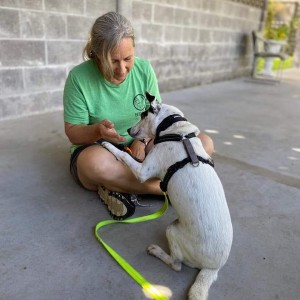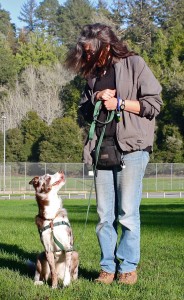The Bait & Switch: How to Better Choose a Dog Trainer/Behavior Consultant
What Really Matters Besides Quality of Knowledge and Experience? Read on for that. (Above photo courtesy of Dawn Goehring)
A while back, I came across a share on Facebook about choosing a dog trainer that gave me some serious pause. While some of the titles sounded quite reasonable, the explanations below those titles were at best, disturbing. So I would like to address each of the suggestions here with some real facts. Before I do that, I want to reiterate that sadly, there is still no regulation in this industry. I have written extensively on this subject, as anyone who follows my writings knows.
The most detailed article that explains various schools and credentials and trade organizations as well as red flag words and phrases is here for your perusal, False Positive . I strongly suggest that you start there before reading further. There was a comment on the original post that concerned me, about the “uncredentialed” trainers sometimes possessing the most experience and expertise. That can actually be true to a certain extent but quite frankly, those “uncredentialed” trainers often possess a graduate degree of some sort in animal behavior that makes spending the extra money on trade organization certifications not at all worthwhile. The note in the original post about “developing their own methods” is a dangerous precedent. Science backs the method or it doesn’t. We don’t get to make up methods and call them valid. There are many ways to implement already existing science backed methods. Varying from the actual science means not believing in it. That’s not quality, that’s quackery. Know the difference.
- They welcome questions. Yes, in fact they do. That much is true. You should always feel comfortable asking your trainer questions. Clarity and understanding is important. I agree with this requirement very much.
- They have well-trained dogs of their own. To a certain extent, yes, of course. But you are not going to meet their dogs anyway so it’s a moot point. The only way that you may meet a trainer’s dog is *if* they have a great teacher dog who helps shy dogs learn to feel safe or dogs with poor social skills to learn better ones and that is your dog’s issue. But that is not going to happen at the first session anyway. And just a note, it’s not a fault of the trainer if they don’t currently have such a dog. Such dogs are born, not made. I had one for 13 years and I miss this dog every single day. You don’t come across such a teacher dog easily. So, don’t judge a trainer who is currently without such a dog. We are not adding dogs to our lives to satisfy others. We add dogs to our lives responsibly, when it’s an appropriate time for us and our other canine family members.
-
They train with methods that they developed. Nope, nope and nope again. As already addressed in an earlier blurb, science is science. There is an abundance of ways to implement modern methodologies. And it’s not a bad thing to see existing methods with a fresh eye and tweak them for use with individual dogs. We all do that all the time. But making stuff up and calling it a method does not a valid method make. There are few new things in dog training and behavior modification. Most are twists of already existing protocols. BAT is different but it’s a method that dogs already did on their own. Grisha Stewart simply fine tuned it and adapted it for assistance on the part of the humans who help worried dogs. There are other examples as well such as Leslie McDevitt’s work. But again, a twist on existing methods. And unless you can entice a famous trainer who travels around the globe regularly, to work directly with you, it behooves you to hire someone well qualified in all implementations of modern dog friendly methodology instead of expecting each trainer to reinvent the wheel. What you should learn to look for is the level of expertise in implementation. Not inventing new things.
- They see you and your dog as an individual. Sounds great, right? It absolutely should be this way. However, in the original post, there is a suggestion that a trainer should not give a client a step by step plan. What? Isn’t that the point of hiring a trainer? To get a step by step plan that can be followed. I know that’s what MY clients expect. And rightly so. Of course, that plan can and does take into account their dog’s individual manifestation of the issues, the human’s ability to carry out the plan, the environment of the individual client and dog, the management of the plan and a whole host of other things. The plan can and should be tweaked at any time, based on progress or not, or any changes that affect the plan. Having a plan is a good thing! Never disregard a quality trainer who has a solid plan for your dog’s issue.
- They have a high client retention rate. Now here we have an idea that I can wholeheartedly get behind! Yes, indeed. Quality trainers have clients who come back with subsequent dogs or even the same dog when a new issue arises. Those long-time clients refer their friends, relatives and colleagues as well. This is definitely an important trait to consider. But also keep in mind that punishment based traditional/balanced trainers also have these kinds of clients. It’s better to choose a trainer whose methodology, expertise and experience you feel comfortable with and *then* see about this part of the equation. Satisfaction with previous experience does not mean that the trainer will be your definition of nice to your dog. And quite frankly, everyone’s definition of nice to their dog should include no hitting, no stringing up on a leash, no leash corrections, no prong collars, no choke chains, no shock collars, no bonkers, no hissing, no poking, no yelling, no scaring, no nothing that is frightening or painful to the dog. Period. No exceptions. The message here is to do your due diligence when hiring a trainer, just like you would or should when choosing any quality professional who you are paying for their education and knowledge. Choose kindness for your dog. You both deserve it.
Posted in: Projects
Leave a Comment (0) →


